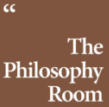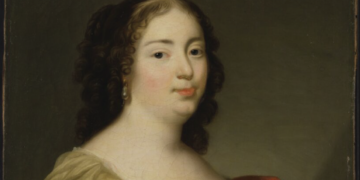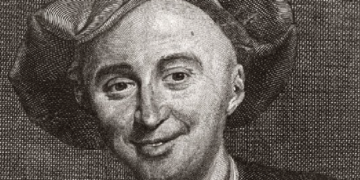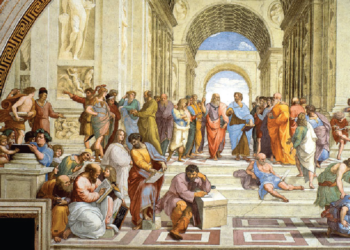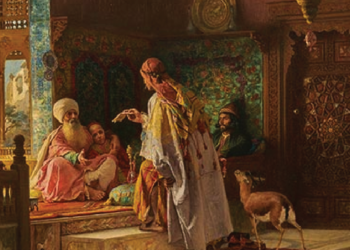Hildegarde de Bingen
1) Her Biography
Hildegarde de Bingen was born in 1098 in Bermersheim, a small village in the Rhineland region of what is now Germany. She was the tenth child of a noble family and was dedicated to the Church as a tithe, a common practice for families with many children. At the age of eight, she was entrusted to the care of Jutta von Sponheim, a female recluse who lived near the Benedictine monastery at Disibodenberg. Under Jutta’s guidance, Hildegarde received a spiritual education that laid the foundation for her later mystical visions and theological writings.
After Jutta’s death in 1136, Hildegarde was chosen to succeed her as magistra of the community of women attached to the monastery. She demonstrated strong leadership and sought to separate her growing community from the male monastery. Despite resistance, she successfully established her own independent convent at Rupertsberg near Bingen around 1150. This move marked a significant moment in her life, symbolising both her spiritual authority and her independence as a religious woman.
From a young age, Hildegarde experienced vivid visions, which she later interpreted as divine revelations. These experiences, though initially kept secret, eventually became the foundation of her major theological works. At the age of 42, encouraged by her confessor and with papal support, she began writing down these visions. The result was her first and most famous work, Scivias (“Know the Ways”), which combined theological insight with detailed and symbolic illustrations.
Hildegarde’s reputation as a visionary and thinker spread throughout Europe. She corresponded with popes, emperors, bishops, and other prominent figures of her time, offering spiritual advice and often criticising corruption and moral failings within the Church. Her boldness in addressing authority figures, despite her position as a woman in a patriarchal religious order, earned her both admiration and controversy.
In addition to her theological work, Hildegarde was deeply engaged with natural philosophy and medicine. She wrote two important scientific texts: Physica and Causae et Curae, in which she documented her knowledge of the natural world and holistic healing. These works combined empirical observation with spiritual belief, reflecting her conviction that the divine was manifest in all aspects of creation.
Hildegarde was also a gifted composer, creating a large body of liturgical music that included hymns, antiphons, and sequences. Her compositions were marked by soaring melodies and unique tonalities, distinct from the more restrained Gregorian chant of the time. Music, for her, was a form of divine praise and a medium through which the soul could commune with the celestial realm.
She continued to write, preach, and govern her convents until her death in 1179 at the age of 81. Her influence did not fade with her passing; she was remembered as a prophetess, healer, and reformer. Although not formally canonised for centuries, she was widely venerated, and in 2012, Pope Benedict XVI officially declared her a Doctor of the Church—a title bestowed upon only a few individuals whose theological contributions are considered of universal importance.
2) Main Works
Scivias (short for Scito vias Domini, “Know the Ways of the Lord”)
Scivias is Hildegarde’s first major theological work, written between 1142 and 1151. It is a visionary text in which she records twenty-six divine revelations, describing the structure of the universe, the nature of God, the role of humanity, and the Church’s place in salvation history. Rich in allegory and symbolism, it includes intricate illustrations and discusses themes such as creation, sin, redemption, and the Virgin Mary. The work reflects her belief that the universe is a harmonious expression of divine order.
Liber Vitae Meritorum (“The Book of the Rewards of Life”)
Written around 1158–1163, this book is a moral and didactic treatise. In it, Hildegarde presents a vivid battle between virtues and vices, dramatising moral choice through allegorical dialogue. Each vice is countered by a corresponding virtue, and their interactions reveal the moral consequences of human behaviour. The work reflects Hildegarde’s concern for ethical living and divine justice, urging individuals to live virtuously to receive spiritual rewards.
Liber Divinorum Operum (“The Book of Divine Works”)
Completed around 1173, this is Hildegarde’s final and most ambitious visionary work. It explores the relationship between God, the cosmos, and humanity, framed within the concept of macrocosm and microcosm. Drawing on natural philosophy, theology, and vision, she portrays the soul as central to the cosmic order. The book discusses divine wisdom, the Incarnation, and the unfolding of history, offering a grand, unified vision of creation as a reflection of divine purpose.
Physica (also known as Liber Simplicis Medicinae, “The Book of Simple Medicine”)
This scientific treatise is a compilation of knowledge about natural objects—plants, animals, stones, and elements—and their healing properties. It presents a world in which nature is seen as imbued with divine purpose and healing potential. Hildegarde’s remedies are drawn from observation and folklore, mingled with spiritual insight. The text reflects her holistic approach to health, wherein physical and spiritual well-being are intertwined.
Causae et Curae (“Causes and Cures”)
A companion to Physica, this work focuses on the causes of diseases and their treatments. It offers one of the most comprehensive medieval discussions of women’s health and includes detailed descriptions of bodily functions, illnesses, and therapies. Hildegarde weaves theological, spiritual, and medical insights into a single text, emphasising that health results from harmony between body, soul, and environment.
Symphonia Armoniae Celestium Revelationum (“Symphony of the Harmony of Celestial Revelations”)
This is a collection of over seventy liturgical songs composed by Hildegarde, including antiphons, hymns, sequences, and responsories. The music is notable for its originality and expressive melodic lines. These compositions were meant for religious devotion and reflect Hildegarde’s view that music was a bridge to the divine. Her lyrics often praise saints, the Virgin Mary, and divine wisdom, with poetic and visionary imagery.
Ordo Virtutum (“The Play of the Virtues”)
This is a musical morality play, possibly the earliest known of its kind, composed by Hildegarde. It features personified Virtues, the Soul, and the Devil in a dramatic conflict over the soul’s allegiance. The Devil is the only character who does not sing, instead shouting, symbolising his separation from divine harmony. The work underscores Hildegarde’s emphasis on spiritual struggle and moral integrity.
3) Main Themes
Divine Vision and Revelation
Central to Hildegarde’s writings is the theme of divine revelation. She believed her visions were granted directly by God, not as dreams or hallucinations, but as lucid and conscious experiences of divine truth. Her major works, including Scivias, Liber Vitae Meritorum, and Liber Divinorum Operum, are structured around these revelations. Through them, she aimed to make complex theological ideas accessible, insisting that she was merely a “feather on the breath of God” transmitting His will. Her visionary mode combined prophetic authority with poetic and symbolic expression.
Cosmic Harmony and the Microcosm-Macrocosm Relationship
Hildegarde frequently wrote about the harmony between the human being (the microcosm) and the universe (the macrocosm). She argued that everything in creation is interconnected and that humanity reflects the divine order of the cosmos. This idea is elaborated most fully in Liber Divinorum Operum, where she presents the cosmos as a living, breathing manifestation of God’s wisdom. Humanity’s health, morality, and destiny are interwoven with the rhythms of the natural world and the workings of celestial bodies.
Virtue and Vice
Moral struggle is a prominent theme, especially in Liber Vitae Meritorum and Ordo Virtutum. Hildegarde dramatizes the battle between virtues and vices, often personifying them in dialogues or theatrical forms. Each virtue is a divine attribute to be cultivated, while each vice represents spiritual disorder. She believed that human life was a continuous journey of moral discernment, with salvation dependent on one’s alignment with divine virtues such as humility, patience, and chastity. The theme serves both didactic and spiritual purposes, encouraging ethical self-awareness.
The Feminine and the Divine
Hildegarde’s works frequently elevate the feminine, both spiritually and theologically. She often described Wisdom (Sapientia) and the Church (Ecclesia) in female terms, embodying divine grace and order. The Virgin Mary held a special place in her writings as the ideal of holiness and redemption. In Ordo Virtutum, the soul is female, engaged in spiritual battle and divine yearning. Hildegarde’s own role as a female visionary also challenged the norms of ecclesiastical authority, asserting that women could serve as conduits of divine knowledge.
Creation and Nature
Deep reverence for nature permeates Hildegarde’s works. In Physica and Causae et Curae, she explores the medicinal and spiritual qualities of natural elements, from herbs and stones to animals and the humours of the body. She viewed creation as a sacred gift, full of divine energy or viriditas—a Latin term she used to describe the greening power of life and spiritual vitality. Her ecological awareness, unusual for her time, treated the natural world as both physically sustaining and spiritually instructive.
Health and Holistic Healing
Hildegarde’s approach to medicine was integrative, linking body, soul, and the natural world. She saw health as a state of harmony among physical, emotional, and spiritual forces. Her medical texts offer remedies grounded in observation, but always framed within a theological context. Illness, in her view, often arose from moral imbalance or spiritual neglect, and healing required attention to both physical treatment and inner transformation. This theme reflects her belief in the divine pattern behind all aspects of human life.
Music and Celestial Order
Music, for Hildegarde, was not only artistic expression but also a theological necessity. She considered music to be an echo of the celestial harmonies of heaven, helping the soul align with divine will. In works like Symphonia Armoniae Celestium Revelationum and Ordo Virtutum, she composed chants and sacred drama that embodied this belief. Her melodies are uniquely expansive and emotive, intended to lift the mind toward God. Music thus becomes a vehicle of revelation, linking human praise with angelic worship.
Prophecy and Reform
A significant undercurrent in Hildegarde’s writings is her role as a prophetic critic of ecclesiastical corruption and moral laxity. She did not shy away from admonishing clergy, emperors, and other powerful figures, often warning of divine judgement. She envisioned her work as a call to reform—personal, institutional, and cosmic. This prophetic voice, legitimised by her visions and her spiritual authority, made her an influential figure in both religious and political spheres of the twelfth century.
4) Hildegarde as a Philosopher
Hildegarde de Bingen stands as a unique figure in the landscape of medieval philosophy, not least because of the distinctively visionary nature of her thought. Unlike many of her male contemporaries, she did not engage in scholastic dialectic or systematic argumentation. Instead, her philosophical contributions emerge through her allegorical visions, theological treatises, and reflections on nature, morality, and the human condition. Her philosophy is deeply integrated with her religious worldview, where truth is not merely deduced through reason, but revealed through divine illumination. This experiential approach challenges rigid philosophical structures and offers a more holistic and symbolic path to knowledge.
At the heart of Hildegarde’s philosophy is the concept of viriditas, often translated as “greenness” or “life-force.” It expresses the generative and sustaining power of God as manifest in the natural world and human beings. For Hildegarde, viriditas is both a metaphysical and ethical principle, reflecting the divine vitality that animates all creation. This idea links directly to her views on the human soul, which she considered as possessing an inner capacity to flourish when aligned with divine harmony. Such an idea resonates with both Neoplatonic and Christian philosophical traditions but is rendered distinctively organic and poetic in her hands.
Her notion of the microcosm and macrocosm also reveals a strong philosophical inclination. Hildegarde proposed that humans are a reflection of the cosmos—a belief that integrates metaphysics, anthropology, and ethics. This idea underscores her belief in the unity and interconnectedness of all creation, a theme that she develops with considerable depth in Liber Divinorum Operum. It also serves as a moral framework: to live virtuously is to live in accordance with the divine order embedded in both nature and the human body. This cosmological orientation places her in conversation with thinkers like Boethius and the broader tradition of natural philosophy.
While she was not trained in classical logic, Hildegarde’s writings exhibit a coherent internal structure and philosophical depth. Her use of allegory, particularly in the portrayal of virtues and vices, illustrates an ethical system rooted in divine justice and spiritual struggle. The Liber Vitae Meritorum offers a vision of moral philosophy in dramatic form, using personification and vision to explore questions of freedom, temptation, and virtue. Through this method, she engages with timeless philosophical questions about the nature of good and evil, the will, and the moral consequences of human choices.
Hildegarde’s treatment of knowledge is also philosophically significant. She saw true knowledge as originating in divine revelation, but also acknowledged the role of experience, contemplation, and observation. Her writings on nature and medicine demonstrate empirical curiosity, but she always integrated this with spiritual insight. In this sense, she can be seen as proposing an integrated epistemology, in which reason and vision, science and faith, collaborate rather than compete. This approach stands in contrast to the more analytical methods of scholastic philosophers but nonetheless contributes meaningfully to the history of medieval thought.
Moreover, Hildegarde offered a powerful reimagining of authority and gender in philosophy. By claiming divine sanction for her visions and speaking with prophetic urgency, she carved out a space for female philosophical voices in a male-dominated tradition. She insisted that her insights were not her own but revelations from God, thus subverting traditional hierarchies while also affirming her intellectual agency. This insistence on inspired speech allowed her to address complex metaphysical and ethical questions, often with a clarity and passion that rivalled her scholastic peers.
Though she was not known in her own time as a philosopher in the traditional academic sense, Hildegarde’s thought has come to be recognised as deeply philosophical in its scope and method. Her influence crosses boundaries between theology, natural science, ethics, and cosmology. In modern scholarship, she is increasingly acknowledged as a philosopher in her own right, whose visionary and symbolic language conceals profound meditations on existence, knowledge, and the divine. Her work stands as a testament to the richness of medieval thought outside the confines of scholasticism.
5) Her Legacy
The legacy of Hildegarde de Bingen is both vast and enduring, reaching far beyond her twelfth-century context to influence theology, philosophy, music, medicine, and feminist thought. In her own lifetime, she achieved widespread recognition as a visionary and spiritual leader, corresponding with popes, monarchs, and religious communities across Europe. Her authority, rare for a woman of her era, was grounded in her reputation as a prophetess and the authenticity of her visions. Even after her death, her writings continued to circulate and be revered in monastic and scholarly circles, ensuring the survival of her thought through the medieval period and into modern times.
In the realm of music, Hildegarde is now celebrated as one of the earliest known composers in the Western canon whose name is known. Her collection Symphonia Armoniae Celestium Revelationum and the morality play Ordo Virtutum are regularly performed and recorded today. Her musical legacy is distinctive for its expressiveness, originality, and theological purpose, offering an alternative to the male-dominated Gregorian tradition. She pioneered a form of sacred music that was both dramatic and lyrical, grounded in spiritual ecstasy and poetic imagery.
Her theological and philosophical influence has grown in significance in recent decades. For many years, Hildegarde’s work remained outside mainstream philosophical curricula, due in part to the visionary and symbolic nature of her writing. However, contemporary scholarship has reassessed her contributions, recognising the depth and coherence of her cosmological and ethical views. Her holistic integration of natural philosophy with theology offers a model of thought that challenges the Cartesian split between body and soul, science and spirituality—making her particularly relevant in present-day interdisciplinary studies.
Hildegarde’s contributions to medicine and natural science have also been revisited with great interest. Her texts Physica and Causae et Curae present a comprehensive view of health that combines empirical observation with spiritual wisdom. Modern alternative medicine and holistic healing movements have looked to her work as a precursor to contemporary ideas about wellness, balance, and the interconnectedness of body and mind. Though not always scientifically rigorous by modern standards, her approach reflects an early understanding of psychosomatic health and ecological awareness.
In the realm of gender and spirituality, Hildegarde has become a significant figure for feminist theology and Christian mysticism. Her assertion of spiritual authority, despite the restrictions placed on women in the medieval Church, positions her as a pioneer of female intellectual and religious agency. She offered a powerful model of divine femininity, frequently invoking female imagery for God’s wisdom and creativity. Her life and writings challenge long-standing assumptions about women’s roles in the Church and in the production of knowledge.
The formal recognition of Hildegarde’s legacy came in a historic act by the Catholic Church when Pope Benedict XVI canonised her in 2012 and, more notably, declared her a Doctor of the Church—a title bestowed on only a handful of saints whose teaching is considered of universal importance. She became the fourth woman to receive this honour, solidifying her status as a major theological and philosophical voice in Church history.
Today, Hildegarde de Bingen’s influence can be felt across a variety of disciplines. She is studied not only in theology and philosophy departments but also in programmes focusing on medieval studies, women’s history, musicology, and environmental ethics. Her ability to bridge the mystical and the intellectual, the visionary and the scientific, continues to inspire readers and scholars around the world. Her legacy endures as a testament to the power of a singular voice that defied convention and revealed the divine through the whole of creation.

